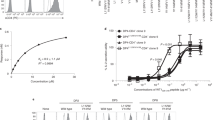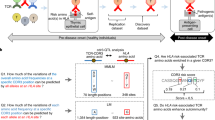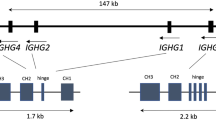Abstract
Class II antigens of the major histocompatibility complex (MHC) consist of two glycosylated, membrane-integrated polypeptide chains1. These cell surface-expressed molecules are involved in several immunobiological events involving cell–cell interactions2,3, most of which seem to require that genetically identical class II antigens, or other molecules controlled by the same region of the MHC, are expressed on the interacting cells4. The extensive genetic polymorphism of the class II antigens5 has rendered analyses in the human system of the number of non-allelic species of class II antigens difficult, although several laboratories have reported the existence of at least two types of human class II antigens6–9. Here we present the results of experiments using restriction enzyme digestions and separation of DNA from individuals homozygous for the MHC followed by hybridization to human class II antigen α-10,11 and β-12–14 chain cDNA probes. While the α -chain probe gave only a single hybridization band, the various β -chain probes revealed a more complex pattern that is consistent with the existence of at least three separate β -chain genes or pseudogenes in the human MHC.
This is a preview of subscription content, access via your institution
Access options
Subscribe to this journal
Receive 51 print issues and online access
$199.00 per year
only $3.90 per issue
Buy this article
- Purchase on Springer Link
- Instant access to full article PDF
Prices may be subject to local taxes which are calculated during checkout
Similar content being viewed by others
References
Kämpe, O. et al. Nobel Symp. Vol. 55 (eds Möller, G. & Möller, E.) (Plenum, New York, in the press).
Thomas, D. W., Clement, L. & Shevach, E. M. Immun. Rev. 40, 181–204 (1978).
Miller, S. D., Sy, M. & Claman, H. N. J. exp. Med. 145, 1071–1076 (1977).
Katz, D. H., Hamaoka, T., Dorf, M. E., Maurer, P. H. & Benacerraf, B. J. exp. Med. 138, 734–739 (1973).
Bodmer, W. F. Br. med. Bull. 34, 3 (1978).
Markert, M. L. & Cresswell, P. Proc. natn. Acad. Sci. U.S.A. 77, 6101–6104 (1980).
Tosi, R., Tanigaki, N., Centis, D., Ferrara, G. B. & Pressman, D. J. exp. Med. 148, 1592–1611 (1978).
Park, M. S., Terasaki, P. I., Nakata, S. & Aoki, D. Histocompatibility Testing, 845–860 (UCLA Press, Los Angeles, 1981).
Corte, G. et al. Nature 292, 357–359 (1981).
Gustafsson, K. et al. Scand. J. Immun. (in the press).
Larhammar, D. et al. Cell 30, 153–161 (1982).
Wiman, K. et al. Proc. natn. Acad. Sci. U.S.A. 79, 1703–1707 (1982).
Larhammar, D. et al. Scand. J. Immun. 14, 617–622 (1981).
Larhammar, D. et al. Proc. natn. Acad. Sci. U.S.A. 79, 3687–3691 (1982).
van Someren, H. et al. Proc. natn. Acad. Sci. U.S.A. 71, 962–965 (1974).
Shows, T. B. & Brown, J. A. Proc. natn. Acad. Sci. U.S.A. 72, 2125–2130 (1975).
Lee, J.S., Trowsdale, J. & Bodmer, W.F. Proc. natn. Acad. Sci. U.S.A. 79, 545–549 (1982).
Silver, J. & Ferrone, S. Nature 279, 436–439 (1979).
Korman, A. J., Knudsen, P. J., Kaufman, J. F. & Strominger, J. L. Proc. natn. Acad. Sci. U.S.A. 79, 1844–1848 (1982).
Auffray, C., Korman, A. J., Roux-Dosseto, M., Bono, R. & Strominger, J. L. Proc. natn. Acad. Sci. U.S.A. (in the press).
Cami, B., Brégégère, F., Abastado, J. P. & Kourilsky, P. Nature 291, 673–675 (1981).
Steinmetz, M. et al. Cell 25, 683–692 (1981).
Steinmetz, M., Winoto, A., Minard, K. & Hood, L. Cell 28, 489–498 (1982).
Kaufman, J. F. & Strominger, J. L. Nature 297, 624–697 (1982).
Southern, E. M. J. molec. Biol. 98, 503–517 (1975).
Author information
Authors and Affiliations
Rights and permissions
About this article
Cite this article
Böhme, J., Owerbach, D., Denaro, M. et al. Human class II major histocompatibility antigen β-chains are derived from at least three loci. Nature 301, 82–84 (1983). https://doi.org/10.1038/301082a0
Received:
Accepted:
Issue Date:
DOI: https://doi.org/10.1038/301082a0
Comments
By submitting a comment you agree to abide by our Terms and Community Guidelines. If you find something abusive or that does not comply with our terms or guidelines please flag it as inappropriate.



